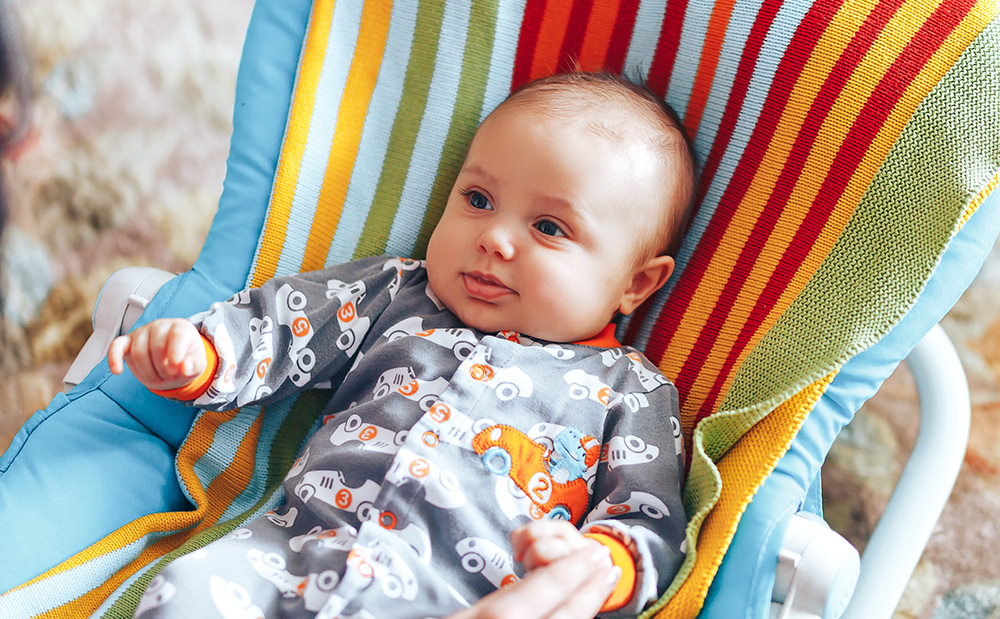
In a recent TikTok video that’s amassed almost 4,000 comments, creator marilynchristopher talks about how sweaty, flushed, and damp her baby is after going for a nap, despite the AC being cranked and only dressing the baby in a sleep suit. (1) Sweatiness can be a sign of overheating — a risk that can increase the likelihood of sudden infant death syndrome (SIDS) and other issues like heat rash.
It’s important to understand the signs of overheating in babies and set up their sleep environment to minimize the risks of SIDS and other concerns so your baby remains comfortable and safe.
Causes and Risks of Sweating and Overheating in Babies
“Babies are more sensitive to heat than adults because they have less effective temperature regulation systems,” explains Dr. Janet Lazieh, a pediatrician with Holy Name Medical Center in Teaneck, NJ. This means babies are more apt to sweat during sleep, especially in warmer temperatures or if they’re overdressed.
Debbie Gerken, a Certified Registered NICU Nurse, Certified Pediatric Gentle Sleep Coach, Postpartum Parent Educator, and founder of Sleep Like a Baby Consulting, says it can take newborns months to manage temperature control. “One reason for this is that babies have immature sweat glands, which makes their ability to regulate temperature not as effective as that of adults,” she explains. Because of this, babies become more sensitive to small temperature changes and minimal activity, which can cause sweating.
Babies also have a higher surface area-to-body mass ratio, which results in more heat being absorbed and retained. Their immature thermoregulation system adjusts to this increased heat retention by sweating to cool down. “Babies also tend to sweat when being held, snuggled, or fed, as contact with a caregiver’s warm body can cause an increase in their own body temperature,” says Gerken.
Sweating while sleeping is a sign that experts warn parents about in babies because it can cause overheating, which is a significant risk factor for Sudden Unexpected Death in Infancy (SUDI) cases. These include SIDS, unknown causes, and accidental suffocation or strangulation in bed. In 2020, the United States reported approximately 3,400 SUDI cases.
An underlying cause is that if babies sweat excessively, their bodies can lose too much fluid, and dehydration can become a dangerous side effect. “Once dehydrated, a baby has a higher risk of overheating because the decrease in fluids can affect the body’s ability to regulate temperature,” explains Gerken.
Gerken says excessive sweating can also make sleep very challenging for a baby. As a baby gets more overtired and irritable, feedings may become more difficult, further exacerbated by dehydration and overheating.
Signs of Overheating
It’s important to monitor your baby for signs of overheating. Keep in mind that newborns might not sweat very much, but they can still overheat. Pay attention and take action if you notice any of these signs:
- Skin is hot to the touch or appears red
- Signs of discomfort or distress, such as if the baby seems fussy, restless, or listless.
- Elevated, rapid heartbeat and breathing
- Baby appears overly tired, listless, or sluggish
- Signs of confusion or weakness
- Nausea or vomiting
How to Prevent Overheating
Preventing babies from overheating is crucial, especially during sleep. Dr. Lazieh stresses the importance of ensuring their sleep environment is comfortably cool and dressing them in breathable clothing. “My best advice to parents is that it’s crucial to keep infants cool and hydrated, avoid direct sun exposure, and dress them in lightweight clothing,” she says.
Pay Attention to Body and Room Temperatures
Monitoring your baby’s temperature and ensuring they’re not overheating is essential, especially during hot weather or if they’re dressed too warmly. Dr. Lazieh says keeping babies well hydrated can also help avoid overheating. To check if the baby is too warm or cold, touch the back of the baby’s neck or back, as their hands or feet might feel cooler even when their bodies are too hot.
Another smart move is to use a baby monitor that measures room temperature. While the American Academy of Pediatrics (AAP) doesn’t suggest a precise temperature range for a baby’s sleep environment, Gerken and the Public Health Agency of Canada recommend 72°F (20°C to 22°C) as an ideal range to set your AC during the summer to avoid overheating. It’s best not to go above 75°F (23.8°C).
Allow for Air Flow
Using ceiling fans or standing fans in a baby’s room can also ensure good air circulation to avoid the air becoming stagnant, which can cause a warmer environment, says Gerken. Dress your baby in layers of lightweight, breathable materials, avoid using too many layers, and use bedding that is also lightweight and breathable. Never use a hat during sleep since hats prevent natural body cooling efforts.
Act Quickly When Overheating Occurs
Gerken says knowing how to identify overheating is necessary so parents can prepare, evaluate the sleeping environment, and respond appropriately before the summer. “If a baby becomes overheated, it is important to take them into a cool environment, remove excess layers, and offer fluids. Parents should continue to assess their baby and notify their pediatrician or call 911 if their baby shows signs of worsening,” she says.
It’s also worth noting that while Marilyn Christopher wonders in her video if a weighted sleep sack would be a better option, the American Academy of Pediatrics published a letter voicing “concern” regarding weighted infant sleep products, including sleepers, swaddles, and blankets.
Sources
1. @marilynchristopher; “Buddy inherits her dads sweatiness,” TikTok; https://www.tiktok.com/@marilynchristopher/video/7351615664534179115?_r=1&_t=8lE8iYgXMQZ; March 28, 2024.
Lazieh, Janet. Author interview. April 2024.
Gerken, Debbie. Author interview. April 2024.



























